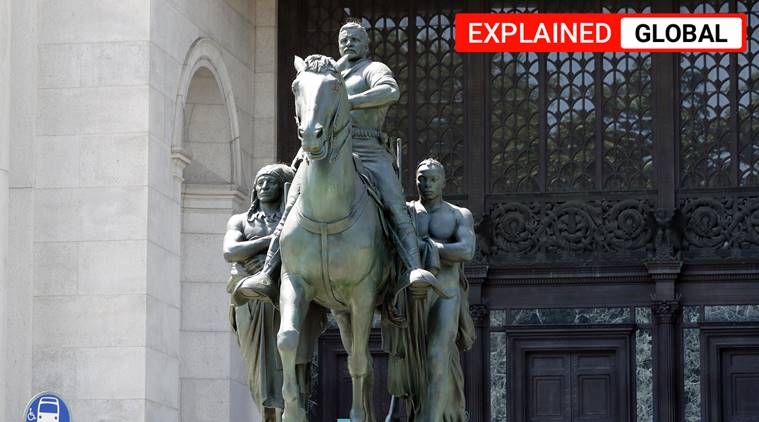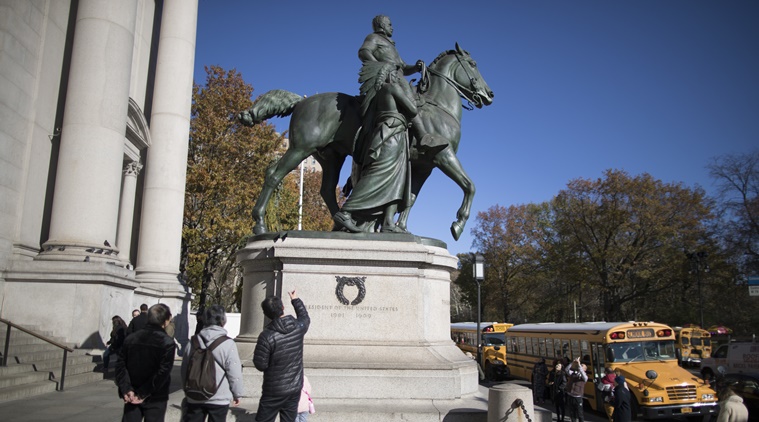- India
- International
Explained: Why the American Museum of Natural History wants to remove Theodore Roosevelt’s statue
Why has the American Museum of Natural History asked the New York City government to remove the statue of Theodore Roosevelt, the 26th President of the United States who was in office from 1901 to 1909?
 A statue of Theodore Roosevelt on horseback flanked by a Native American man, left, and an African man, right, sits in front of the American Museum of Natural History, Monday, June 22, 2020, in New York. (AP Photo: Kathy Willens)
A statue of Theodore Roosevelt on horseback flanked by a Native American man, left, and an African man, right, sits in front of the American Museum of Natural History, Monday, June 22, 2020, in New York. (AP Photo: Kathy Willens)
The killing of George Floyd, an African-American man in the US in May, led to mass protests against racism and police violence and brutality. As these protests spread to other parts of the world, protesters began pulling down statues and defacing monuments across the US, the UK and Europe that were representative of slavery and colonialism. This weekend, the New York City government announced that a large statue of former US President Theodore Roosevelt that stands outside the American Museum of Natural History will soon be taken down. The statue is a property of the city government and is located on the museum’s main entrance, on Central Park West.
Why will Roosevelt’s statue be taken down?
The American Museum of Natural History has asked the New York City government to remove the statue of Theodore Roosevelt, the 26th President of the United States who was in office from 1901 to 1909. Last year, the museum held an exhibition titled ‘Addressing the Statue’ that focused on this particular statue, officially called “The Equestrian Statue of Theodore Roosevelt”. Six years after Roosevelt’s death, the statue was commissioned in 1925 to stand on the steps of the museum and was unveiled to the public in 1940. According to the American Museum of Natural History, the statue was a part of a larger New York State memorial to Roosevelt who had also served as New York state governor from January 1, 1899 – December 31, 1900.
Roosevelt was also deeply interested in natural history and conservation and his father Theodore Roosevelt Sr. had also been one of the museum’s founders. Back then, the museum had said that it was “proud of its historic association with the Roosevelt family”. On Sunday, New York City Mayor Bill de Blasio announced in a statement that the museum had decided to remove this statue of Roosevelt because “it explicitly depicts black and indigenous people as subjugated and racially inferior”.
Why is Roosevelt’s statue problematic?
The statue depicts an imposing figure of Roosevelt atop a horse with the figures of an African-American man and a Native American man on his either side. For its exhibition last year on the statue, the museum issued a statement acknowledging that it was problematic. “At the same time, the statue itself communicates a racial hierarchy that the museum and members of the public have long found disturbing,” the museum had said. The museum had explained at the time of the exhibition that it had wanted viewers to ask themselves whether the statue was problematic by experiencing the exhibition and the various perspectives displayed as part of the exhibit.
Controversies around this statue is hardly new. The earliest conversations around it can perhaps be traced to James Loewen’s book ‘Lie Across America: What Our Historic Sites Get Wrong’ published in 1999, where the author wrote that the arrangement of the figures, with Roosevelt sitting in an imposing manner on a horse, with two smaller figures of an African-American man and a Native American man on either side, advocated white supremacy.

Over the years, historians and critics have said that the statue is problematic for many reasons, including its representation of imposed social hierarchies.
Don’t miss from Explained | How George Floyd protests have forced a reckoning among top US brands
 The statue will be coming down after the museum’s proposal to remove it was approved by the city. (AP Photo: Mary Altaffer)
The statue will be coming down after the museum’s proposal to remove it was approved by the city. (AP Photo: Mary Altaffer)
What is New York’s stance on colonial monuments?
In September 2017, New York City’s Mayoral Advisory Commission on City Art, Monuments and Markers announced that it had started discussions with the mayor on controversial public art, historic monuments and markers on property owned by the city government. The Commission had stated that one of its goals were to “focus on adding detail and nuance to – instead of removing entirely – the representations of these histories.” This statue of Roosevelt has also been a subject of discussion for a few years now between museum authorities and the city government but the two had been unable to reach a decision regarding the future of the statue.
In 2019, the museum had said on its website that as part of this initiative by the New York city government, the museum was also trying to provide “new context and perspectives, presenting the history and rationale for the (Roosevelt) statue while explicitly acknowledging its troubling aspects”.
It is not immediately clear when the statue will be removed from outside the museum and if it will be shifted anywhere. The Roosevelt family’s association with the museum continues to this day, with Roosevelt’s great-grandson being one of the institution’s trustees. News reports say that as compensation for the removal of his Roosevelt’s statue, the museum’s Hall of Biodiversity will be named after him.
Was Roosevelt racist?
Last year, before the exhibition on Roosevelt’s statue opened at the museum, The New York Times published an op-ed titled ‘Who owns Theodore Roosevelt’ by Clay Risen, who wrote that racism was “central to Roosevelt’s vision for America, and not just an artifact of his time and place”. There have been other research papers and books published on the subject of racism in the US in which Roosevelt finds mention.
📣 Express Explained is now on Telegram. Click here to join our channel (@ieexplained) and stay updated with the latest
Historians believe that Roosevelt was also a supporter of eugenics, so much so that in 1905, he gave a speech where he attempted to push the narrative of the purported threats of “race suicide”. Critics of the 2019 exhibition at the American Museum of Natural History had said at the time that these aspects of Roosevelt’s identity had not been addressed by the museum nor widely mentioned.
More Explained
EXPRESS OPINION
Apr 20: Latest News
- 01
- 02
- 03
- 04
- 05








































